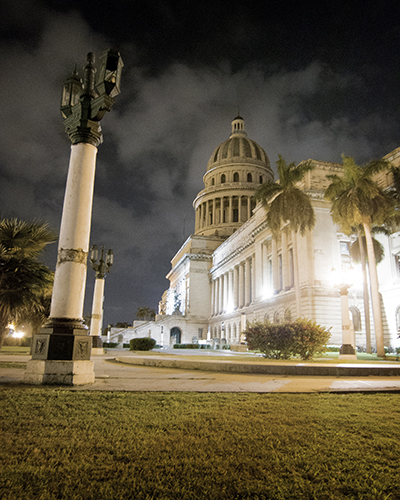
New Mexico Highlands University media arts graduate student Mariano Ulibarri photographed this night image of the historic capitol building in Havana, Cuba during a student cultural exchange in January.
Las Vegas, N.M. — Six New Mexico Highlands University media arts students traveled to Havana, Cuba in January for a cultural exchange that included creating three-dimensional photographic models of architectural treasures to aid preservation.
Media arts professor Megan Jacobs led students in her advanced photography course to Cuba, where they used their lenses to capture the 16th-century city’s dynamic culture — with a focus on the rich history of architecture and the arts. They also chronicled the lush rural landscape of nearby Viñales.
Georgia O’Keefe Museum conservator Dale Kronkright helped lead the study-abroad expedition, which entered the country through a Cuban People to People travel license.
“In Cuba, the dedication to the arts, despite limited resources, is impressive,” Jacobs said. “We were welcomed warmly, with so much pride in their culture.
“Architecturally, Havana is paradise and the buildings are visually stunning. Havana is in the process of revitalizing its treasured historic buildings,” Jacobs said.
In planning the exchange, Jacobs worked closely with Cuba’s Office of the Historian, the Instituto Superior de Arte, or ISA, and others, helping pave the way for her students to participate in numerous professional growth experiences.
Graduate students Eli Gonzales, Billy Grassie and Mariano Ulibarri participated along with undergraduates Arianna Andreatta, Nick Casados, and Shanoaleigh Roseby.
One highlight was when the students were given a private tour of the majestic Havana capitol building, which is closed for restoration. The students produced a 360-degree virtual video tour of the interior for the Office of the Historian.
Jacobs’ photography students are skilled in photogrammetry, a cutting-edge computational photography process that uses two-dimensional still images to create three-dimensional models.
On another day, Jacobs and her students demonstrated photogrammetry techniques to Cuban architects and historians. The students used a touch screen to showcase a photogrammetry 3-D model they created for one of Havana’s famous historic hotels.
“These 3-D models created from the students’ photographs serve as records of these historic buildings, preserving important cultural and historic data,” Jacobs said. “The Office of the Historian wants us to return and present in-depth workshops on photogrammetry.”
Ulibarri, 31, is a fourth-generation Las Vegas native who jumped at the chance to participate in the Cuban study abroad. In May, he will complete his graduate studies in media arts with an emphasis in multimedia.
“The Cuban exchange was a profound life-changing experience for me,” Ulibarri said. “The opportunities I’ve had through media arts continue to amaze me.
“It was very rewarding to see how our photogrammetry techniques could help the Office of the Historian with their preservation efforts in Havana. They were amazed that 3-D modeling was even possible, and immediately grasped how this technology tool could be used in their workflow for building preservation,” Ulibarri said.
Another memorable experience for Ulibarri was when the group visited the Angela Landa primary school in the heart of Old Havana, where he did portrait photography of 5th graders.
“I felt a strong connection with the children through the camera lens,” said Ulibarri, a former teacher. “It was powerful to see the happiness and confidence in their faces.”
The media arts students’ eight-day immersion in Cuba also included photographing and filming dancers at the famed Pro Danza Ballet Academy, meeting with well-known Cuban photographers and a graphic designer, viewing leading photography exhibits, and more.
The students are sorting through their best work from Cuba for a multimedia exhibit that will show in the media arts east exhibit space at 901 University Ave. The opening reception is March 5 at 12:30 p.m. and the exhibit continues through May 2.
“The students created professional, innovative work that resonated with the Cubans, and we hope will resonant here,” Jacobs said. “The exhibit offers a superb taste of the sights, sounds, and tastes of Cuba — a vibrant culture in the midst of great social and political change.”
The media arts cultural exchange with Cuba was made possible with support from Los Alamos National Security, LLC, the Highlands University Foundation, the Student Senate and Canteen Fund, and Friends of Media Arts, and university funding.
